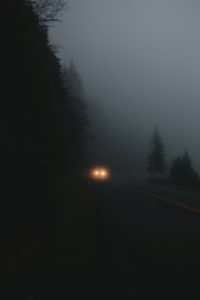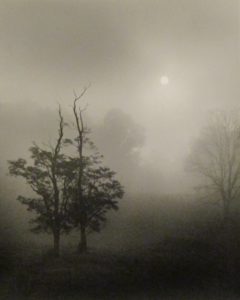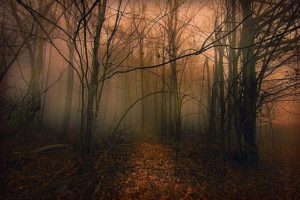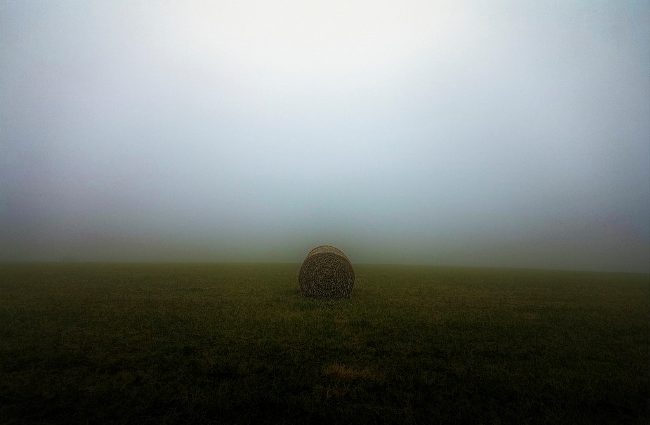The following beautifully written article by Adam Miller first appeared on the site Waking Up in Boone.
It was foggy almost that whole Saturday. I left the mountain in the morning driving with flashers and lights at a creeping pace on my way to Hickory. On the way home the fog was still thick, which is what I was hoping for.

Intentionally I turned north onto the Blue Ridge Parkway. I could easily have gone another simpler safer way, but I wanted to experience what the Parkway is like when the whole mountain is caught in a cloud. I estimate that the visibility was at ten, maybe fifteen, feet which means you can’t see a thing until you’re almost right up on it.
This included other cars and the edges of the Parkway where a miscalculation might mean driving into a ditch or car, or it could mean one of those dramatic scenes in movies when a car launches from a mountainside into the tall trees below.
I wasn’t interested in doing those things, but I did appreciate the quality of concentration provided through a little healthy fear of dying. And once I accounted for some of those risks, I slowed to about six miles an hour.
Fog Sharpens the Senses

A really good, thick fog is sort of like the snow up here in the way that it creates new worlds out of nearly everything. But driving through the fog, especially on the Parkway that Saturday, was sort of like being transported into an alternate dimension and it was like this for probably a good five miles.
The experience forced me to exercise a precious and atrophied ability—the ability to slow down the body and sharpen the mind. The things that came into view were richer in color and texture.
The rhododendron was an entirely new shade of green. The rocks were new shades of silver and gray and black and lichen white. The grasses I could see were nearly red. I caught glimpses of sections of the winter forest that I’d never gone slow enough to appreciate before.
In this way, the fog provided a fleeting opportunity to experience the mournful distinction Wendell Berry makes between roads and paths.
A path is little more than a habit that comes with knowledge of a place. It is a sort of ritual of familiarity. As a form, it is a form of contact with a known landscape. It is not destructive. It is the perfect adaptation, through experience and familiarity, of movement to place; it obeys the natural contours; such obstacles as it meets it goes around. A road, on the other hand, even the most primitive road, embodies a resistance against the landscape. Its reason is not simply the necessity for movement, but haste. Its wish is to avoid contact with the landscape; it seeks so far as possible to go over the country, rather than through it; its aspiration, as we see clearly in the example of our modern freeways, is to be a bridge; its tendency is to translate place into space in order to traverse it with the least effort. It is destructive, seeking to remove or destroy all obstacles in its way.
To be resisted by the mountain is a good thing. To be forced to drive fog-slow on the Parkway was a thing of grace. It led to some good honest driving and some good honest looking that can only happen at certain slower speeds.

This, of course, led to the conviction that I assume Wendell Berry would appreciate all of us having a little bit more of—that there’s just too much passing through happening around here.
Being in a place, moving with it, becoming a part of it for a little while, and allowing it to become a little part of you. Obeying the natural contours of a place.
I was talking to Joey Henson recently. He’s a climber and an artist in the High Country. He talked about this idea of la la land. That even 50 feet into the woods is often enough to get lost in the world and experience a little of the magic that every square inch of earth contains if we slow down enough. Slow down to a stand-still pace so that our minds and our bodies have moments to remember we weren’t born for these kinds of speeds. Not born simply to pass through.
___________
At Thunder Hill Overlook (Map) the clouds seemed to lighten, at least enough to tell I was at an overlook and by the time I was at Raven Rock I could see the rocks and the outlines of trees well enough to take a few photos of the rocks and trees. Then the fog seemed to break on me, first in a slight drizzle and then into large drops that seemed to explode on impact. I was sad to see the fog go and to see the world in that normal way again.
Our heartfelt thanks to Adam Miller for granting Appalachia Bare permission to publish “Seeing Through the Fog.”
**Featured image “Hay in a Foggy Field,” Blue Ridge Mountains by Donnie Nunley – Wikimedia

Thank you for a very thoughtful and poetic perspective. I’ve bicycled on the BRP in the fog—it truly is an exercise in mindfulness and concentration. More frightening are those drivers that, even on clear day, are in a “fog.”